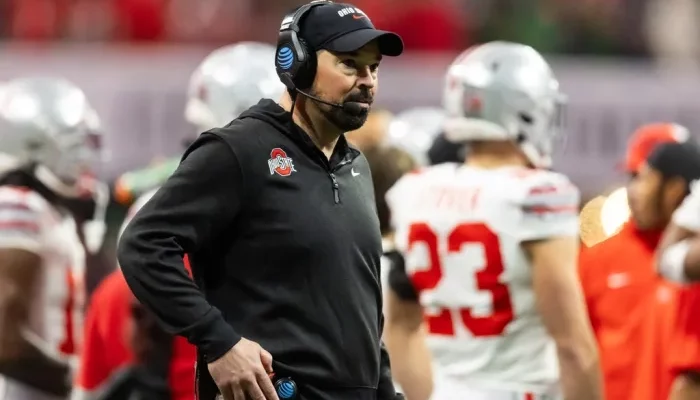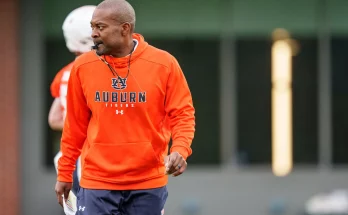Another top college football program outperformed the Ohio State Buckeyes for a top quarterback recruit.
Ohio State recruiting fans were stunned this week when news dropped that Teddy Jarrard, a 4‑star quarterback from North Cobb High School in Kennesaw, Georgia, chose Notre Dame over the Buckeyes, along with Michigan, Penn State, and other top programs. Jarrard was ranked No. 14 at his position in the 2027 class and seen as one of the most elite passers available. Ohio State had been in hot pursuit, hoping to land him as part of their next wave of quarterbacks. But Notre Dame won the race—and the Buckeyes were left empty‑handed.
Ohio State head coach Ryan Day had been clear: they wanted two quarterbacks in the 2027 class. Early last December, they secured Brady Edmunds, a four‑star passer from Minnesota, drawing approval as a strong foundation for the room. Edmunds arrived on campus soon after his unofficial visit, showing Ryan Day was serious about building long‑term depth. Adding Jarrard alongside Edmunds would’ve strengthened the group even more. Instead, they’ll return to focus on developing internal competition among returning players and relying on portal additions if needed.
The loss underscores the shifting nature of the recruiting battlefield, where even traditional landing spots like Ohio State must compete with powerhouses across the country. Notre Dame’s ability to outflank the Buckeyes for Jarrard showed that legacy schools remain threatening threats. They offer stability, nfl pipeline, academics, and prestige—all big draws for recruits. Jarrard, the 6‑3, 200‑pound quarterback from Georgia, likely weighed those factors heavily. In today’s game, landing an elite QB isn’t just about football; recruits balance coaching style, academic fit, NIL potential, proximity to home, and media exposure.
Ohio State’s quarterback room depth, fueled by recent success and multiple star reps, gives them advantage but not always enough to lock up recruits. Jarrard had long been on their radar. His junior year was huge: over 2,700 yards passing and 31 touchdowns at North Cobb. That caught national attention. The Buckeyes offered relatively early and cultivated a relationship.
Sources say Ohio State made their final push as Jarrard’s recruitment narrowed in late summer. They hosted him for an official visit, showed off top facilities, introduced staff and current QBs, and showcased guard of the program’s recent national title and development of quarterbacks like Justin Fields, C.J. Stroud, and Will Howard. He reportedly felt welcomed and valued. But Notre Dame’s timing and emphasis on Jarrard’s development and value—on and off the field—sealed his commitment to South Bend.
Ohio State fans are disappointed. Many thought landing Jarrard could be a pivotal moment, reinforcing national title hopes and ensuring quarterback succession. With Edmunds expected to develop over time and returning portal QBs possibly filling gaps, losing out on Jarrard means reduced QB depth and more pressure to identify future starters internally. Ryan Day now faces two key decisions: continue chasing elite portal quarterbacks or double‑down on in‑house development.
This setback is more than a single recruitment loss—it signals increased competition in college football’s elite recruiting landscape. Members of Ohio State’s 2027 QB board have started clearing out. Jarrard went Notre Dame. Other big names are already spoken for or leaning elsewhere. The Buckeyes retained Edmunds, but they still need additional elite talent to keep a pipeline flowing.
Ohio State’s quarterback situation for 2025 and 2026 remains solid. In 2025, the room is led by Tom Sayin and Lincoln Kienholz, developing under Ryan Day’s veteran staff. A second quarterback class in 2027 would’ve given Day two years of developmental depth before passing the mantle fully. Now there may be a gap. Losing Jarrard refocuses attention back on current QBs and any portal options needed to supplement.
Still, Ohio State remains strong. They planted seeds early with Edmunds and have recruited well across multiple positions. Losing a single QB doesn’t derail plans, but it does require adjustments. They’ve proven capable of responding through the portal, as they did recently when selecting Will Howard for 2023. Day’s comments at Big Ten Media Days show their willingness to keep the in‑house room if possible but not afraid to look externally if it means NC contention.
Meanwhile Notre Dame’s win reflects a changing landscape. Even small‑market Midwestern schools can brief elite QBs away from programs like Ohio State by beating them to key recruits. Brady Edmunds remains an important priority for the Buckeyes, but he’ll now likely become the No. 1 QB more quickly than expected. That brings pressure and opportunity. Edmunds must develop faster, show readiness, and stay healthy any delay opens the door for a new portal arrival in 2025 or 2026.
As for Jarrard, he’ll enter high school senior season with all eyes on him. A Notre Dame QB means national spotlight. He’ll have access to top coaches and resources. He chose a program that trusts its QBs to succeed in NFL, athletics, academics, and media projection. That speaks volumes about his goals and Notre Dame’s pitch.
Ohio State will watch others too. Michigan continues strong recruiting momentum, flipping a top‑100 QB Brady Hart in the 2026 class. Penn State got another returning face with Drew Allar. Georgia, Tennessee, Texas they’re all assembling deep QB rooms. The Buckeyes now stand out by doubling down on development and portal strategy, rather than doubling down solely on recruiting.
The Jarrard miss could help reframe Ohio State’s message: we build quarterbacks here. Players develop, they stay, they step up. This corps may not rely on blue‑chip signings, but strong coaching, stability, and a proven track record of NFL readiness. That’s still a compelling pitch—as Edmunds and others can testify.
Ohio State boosters, fans, and staff will surely revisit the recruiting pitch. NIL, visit logistics, relationships it all matters. Landing babies means perfect pitching and timing. Notre Dame won that battle this time. For Day and the Buckeyes, next comes execution. Edmunds, Sayin, Kienholz, St. Clair all must take shape soon. Otherwise, the Jarrard loss could loom larger.
If fans worry, they should remember University of Washington and Georgia pivoted after missing QB targets recently—and still grew into Power 5 titles. Ohio State can do the same. They’ve thrived through adversity and used the portal well in recent years.
Still, losing Jarrard before official signings feels different. Momentum matters in early July. Losing a QB recruit makes ripple effects across positions, summer builds, and team morale. Staff must rally. It’s game prep now, jockeying for the next opportunity whether development, transfer, or future recruiting.
In the end, college football will always be a battle for elite talent. Ohio State lost a quarterback now. But their system remains strong. Ryan Day’s challenge: augment in‑house growth, continue aggressive portal oversight, convince recruits and fans this loss doesn’t stall future championship plans.
The 2027 QB class is not closed, though. Buckeyes can still sign another four‑star, maybe even a five‑star, later this summer or early fall. They remain Ohio State. If Edmunds proves himself on the field, the reaction to losing Teddy Jarrard fades.
But for now, Notre Dame celebrates a major win. Ohio State collects a lesson: at this level, every recruit matters. The next opportunity could be right around the corner or a game away.
In college football, recruitment never sleeps. Ohio State must respond quickly. They have the platform. They have the coaches. They have the tradition. Brady Edmunds, the portal, and next cycle prospects will define this moment now. Missing Teddy Jarrard is a hiccup, not a downfall but it demands action. Buckeyes will be watching the door, working to strike again with energy and urgency.



